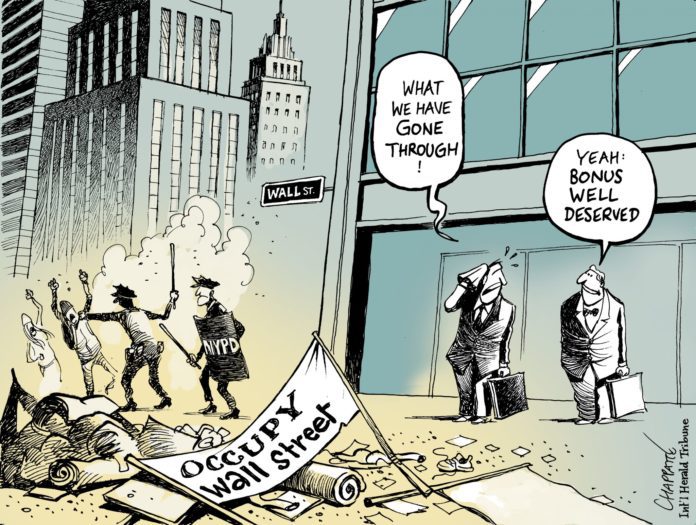BY DANNY M. ADKISON
A few weeks ago the police were dragging Occupy Wall Street protesters out of Zucotti Park. The police arrested nearly 200 individuals. Then dozens of like-minded individuals were arrested in Los Angeles and Oakland. Likewise in various cities in Oregon, Illinois, Minneapolis, and several other states. One protester was shouting, as they dragged him from the park, “I have my constitutional right!”
Well, yes he does. But this right is more complicated that one might think. Free speech, freedom of the press, freedom of religion, these are First Amendment phrases that not infrequently are the focus of stories on the evening news. Not so much the other right mentioned in that amendment: right to peaceably assemble.
Which is kind of odd since that is one of the oldest and most cherished of America’s freedoms. It was one of the rights listed in the Magna Charta and the English Bill of Rights. It was also prominent in our Declaration of Independence. Of the states having bills of rights in their constitutions following the revolution, four explicitly mentioned it.
The first right in the Bill of Rights to ever be applied to the states was the First Amendment’s free speech provision. Right of assembly was the second such right [prior to religion, search and seizure, and right to trial by jury].
The Supreme Court decision that applied the right of assembly to the states was decided by unanimous court. It dealt with some communists who were assembling in Oregon. In overturning the conviction of a man in attendance, the court noted, “Peaceable assembly for lawful discussion cannot be made a crime.”
The right has been particularly important in the establishment of the so-called public forum doctrine. Much of the constitutional discussion over the right has been where people may assemble. The notion of a public forum is important because its existence is where an individual’s right to express himself is at its apex. The Supreme Court has recognized three types of public forum.
One is “public property which is not by tradition or designation a forum for public communication.” An example of this would be the internal mail system used in a public school. Another one “consists of public property which the state has opened for use by the public as a place for expressive activity.” An example would be the atmosphere on some state university campuses. Finally, there are those “places which by long tradition or by government fiat have been devoted to assembly and debate.” An example would be streets and parks.
Ah, parks. That was what was involved in the case of the Wall Street Protesters. What the court has said is that when it comes to public forums, the government may pass time, place, and manner restrictions on assemblies. But – and this is an important but – the restrictions must be content neutral. It is important to remember that streets and parks are the forums that the court has been most amenable to protecting in terms of allowing those assembling to demonstrate and express themselves. So that would be the case of those encamped at Zucotti Park, right?
Actually, Zucotti Park is privately owned. But it is still a park. One could say it is a quasi-park. Is there anything in constitutional law which would relate to a privately owned park which is open [generally] to the general public? How about a company town [an older notion during mining days]? Or more contemporarily, what about a shopping mall? Shopping malls, though mostly privately owned, have the feel of being a public place.
Concerning the former, in 1946 the court ruled that in spite of the fact that a company town was privately owned, individuals still had the right to distribute religious circulars. In the case of shopping malls, in a late 1960s decision the court ruled that shopping malls, though privately owned, were to be treated as public forums. In the 1970s, however, the court changed direction [following several new Nixon appointees] and now asserted that comparing shopping malls to a public forum was a mistake. Rather, the court suggested, as law professor Kenneth Karst put it, “that a shopping center owner had a constitutionally protected property right to exclude [forms of expression].” That’s the way things stand today.
The problem for the original protesters of the Occupy movement would seem to be that Central Park just isn’t close enough to Wall Street.
– Dr. Danny M. Adkison teaches constitutional law at Oklahoma State University and is a regular contributor to The Oklahoma Observer








